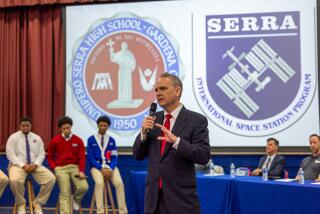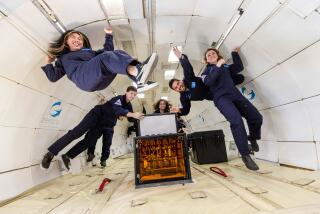Career Launching Pad : Space Day Aims to Give Students a Lift Toward Science
- Share via
Happy Space Day.
That’s right. Today is the first Space Day, an event designed to highlight the growing importance of space-related industries and encourage schoolchildren to pursue careers in science and engineering.
Aerospace giant Lockheed Martin Corp. of Bethesda, Md., is spearheading the effort to establish Space Day, which is also backed by a slew of industry and educational groups. Organizers hope to celebrate Space Day every year on the Thursday preceding May 25--the anniversary of President John F. Kennedy’s famous 1961 speech that committed the United States to sending a man to the moon.
Space Day organizers expect about 2 million students--including some from Long Beach, Oxnard and Palmdale--to participate.
Satellites and other space technologies have come to play an integral--if unsung--part in American lives, providing services ranging from weather forecasts to live television news reports to navigation aids in rental cars.
With direct-broadcast television, wireless mobile phone service and even Internet access increasingly provided via satellite, growth prospects for the commercial space industry are, well, sky high.
*
That worries people like Mel Brashears, president and chief operating officer of Lockheed Martin’s space and strategic missile sector. Brashears is concerned that Americans’ sanguine attitude puts the country at risk of losing market share to more aggressive firms in Europe and Asia.
“We want to make sure school systems are training enough engineers and mathematicians and scientists and computer scientists that we have a work force trained so that the U.S. can capitalize on this expanding marketplace,” said Brashears, who forecasts annual industry growth of 15% to 25%.
Other countries devote more educational resources to math and science, and Americans rank near the bottom of lists comparing test scores of students from Western nations. The number of college students graduating with degrees in aerospace-critical fields, such as electrical engineering and computer science, is down 13% and 22%, respectively, since 1991, according to figures from the National Science Foundation.
The Challenger Center in Alexandria, Va., will host an “electronic field trip,” a television broadcast to classrooms in which students will make a scale model of the solar system, discuss NASA missions to Mars and Saturn, and make a comet out of dry ice, sand, ammonia, water and soda.
There’s also a fact-laden Web site (https://www.spaceday.com) that will outlive Space Day to encourage students year-round.
There are no field trips for grown-ups, but Jack Flannery, executive director of the U.S. Space Foundation in Colorado Springs, Colo., said it’s just as important for adults to appreciate the importance of space industries so that they will support the funding of NASA and other critical space programs.
Karen Kaplan covers aerospace, technology and telecommunications for The Times. She can be reached via e-mail at Karen.Kaplan @latimes.com.
(BEGIN TEXT OF INFOBOX / INFOGRAPHIC)
Space Crunch
American colleges and universities are producing fewer graduates in aerospace--critical fields such as electrical engineering and computer science. Meanwhile, demand for engineers with those skills is rising--Lockheed Martin expects the commercial aerospace industry to grow 15% to 25% a year. The company organized Space Day to head off a shortage of engineers in the next 10 years. Bachelor’s degrees awarded by year (rounded to nearest 500):
Electrical engineering
23,000
--13% since 1991
Computer Science
18,000
--22% since 1991
Source: National Science Foundation
More to Read
Sign up for Essential California
The most important California stories and recommendations in your inbox every morning.
You may occasionally receive promotional content from the Los Angeles Times.











